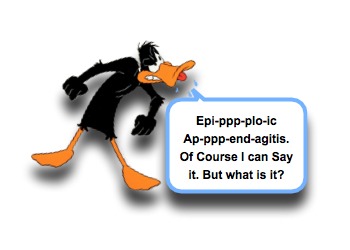Epiploic Appendagitis
Abdominal pain is a challenging complaint. We have to discern between the critical abdominal conditions (ex, Appendicitis, Volvulus, Pancreatitis) from the less concerning causes (ex, CRAP, Constipation, Gastroenteritis). We also have to consider the causes that are not in the abdomen (ex, Strep Pharyngitis, PID, Ovarian Torsion, Pneumonia). While our clinical skills will be the most important tool we use to sort through the lengthy differential, there are times when testing/imaging may be helpful; however, with every test comes the potential for “surprises.” Let’s take a minute to review one of those possible “surprises” that may be the cause of a child’s abdominal pain- Epiploic Appendagitis:
Epiploic Appendagitis: Basics
- Epiploic Appendages (AKA, appendices epiploicase) are fat-filled structures that are on the outside of the large colon. [Redmond, 2015]
- They are most numerous on the sigmoid colon and cecum.
- They are located on the anti-mesenteric side of the colon.
- Each appendage is connected by a vascular stalk that contains artery and vein supplied from the underlying colon. [Chu, 2018]
- Torsion or thrombosis of the epiploic appendage can cause:
- Ischemia of the epiploic appendage. [Redmond, 2015]
- Inflammation of the surrounding tissues (bowel wall, mesentery, peritoneum). [Redmond, 2015]
- May mimic:
- Appendicitis
- Acute Cholecystitis
- Cholangitis (in adults)
- Diverticulitis (in adults)
- Epiploic Appendagitis:
- Is uncommon in children
- True incidence not known.
- More commonly affects the cecum in children, but can involve descending colon and sigmoid colon. [Redmond, 2015]
- Presents with Abdominal Pain that is:
- Steady
- Often localized
- Located in the RLQ most often in children (Adults more often have LLQ) [Redmond, 2015]
- In children, may be associated with: [Redmond, 2015]
- Anorexia
- Nausea / Vomiting
- Low-grade fever
- May have point-tenderness, but rarely has rebound or guarding. [Redmond, 2015]
- Is uncommon in children
Epiploic Appendagitis: Imaging
- Epiploic Appendagitis can be diagnosed on CT, Ultrasound (U/S), or MRI. [Chu, 2018]
- It may also be diagnosed intraoperatively in patients who’s exam and story is concerning enough to warrant a trip to the OR instead of the radiology suite (yes, that is something that can happen even today!).
- Ultrasound (U/S) Features
- Mass with thick rim of enhancement and a hypoechoic central area. [Chu, 2018; Menozzi, 2014; Gorg, 2009]
- Non-compressible mass adjacent to the colon. [Ozturk, 2018]
- Considered 1st line imaging option. [Boscarelli, 2016]
- CT Features
- Characteristic findings that are considered pathognomonic [Chu, 2018; Redmond, 2015]
- Oval/round fat attenuated lesions less than 5cm in diameter
- Located on antimesenteric side of the colon
- Surrounding inflammatory changes on the anterior side of the colon
- MRI Features
- Oval-shaped lesions; 1-4 cm in size
- T1-weighted – High signal intensity center and Low signal intensity rim [Boscarelli, 2016]
- T2-weight may show hypo intense central region (“central dot sign”) related to engorged or thrombosed central vessels. [Boscarelli, 2016]
- Gadolinium contrast will reveal increased enhancement due to inflammatory changes. [Boscarelli, 2016]
- Other considerations would be: [Redmond, 2015]
- Omental Infarction
- Mesenteric panniculitis
- Fat-containing tumor
- Inflammatory conditions of the colon
Epiploic Appendagitis: Management
- Epiploic Appendagitis is primarily a self-limited condition. [Ozturk, 2018]
- Management is largely focused on symptom management.
- Antiemetics and analgesics (ex, NSAIDs) are the primary therapies.
- ANTIBIOTICS are NOT required for most cases.
- Symptoms typically:
- Improve in 72 hours and
- Resolve within 3 weeks.
- Rarely is surgery required:
- If symptoms persist or condition becomes complicated, it may be warranted.
- For recurrence of the condition, surgery may be warranted. [Ozturk, 2018]
Moral of the Morsel
- The List is Long! Here is another item that isn’t appendicitis that can fool us. Appreciate the vast possibilities.
- Don’t be Surprised! That U/S may not show what you thought it would… it may show Epiploic Appendagitis instead.
- Don’t throw antibiotics at it! I know it is an “-itis,” but it isn’t an antibiotic deficiency.
References
Ozturk M1, Aslan S1, Saglam D1, Bekci T2, Bilgici MC1. Epiploic Appendagitis as a Rare Cause of Acute Abdomen in the Pediatric Population: Report of Three Cases. Eurasian J Med. 2018 Feb;50(1):56-58. PMID: 29531496. [PubMed] [Read by QxMD]
Chu EA1, Kaminer E2. Epiploic appendagitis: A rare cause of acute abdomen. Radiol Case Rep. 2018 Mar 23;13(3):599-601. PMID: 30073043. [PubMed] [Read by QxMD]
Boscarelli A1, Frediani S1, Ceccanti S1, Falconi I1, Masselli G2, Casciani E2, Cozzi DA3. Magnetic resonance imaging of epiploic appendagitis in children. J Pediatr Surg. 2016 Dec;51(12):2123-2125. PMID: 27712889. [PubMed] [Read by QxMD]
Redmond P1, Sawaya DE, Miller KH, Nowicki MJ. Epiploic Appendagitis: A Rare Cause of Acute Abdominal Pain in Children. Report of a Case and Review of the Pediatric Literature. Pediatr Emerg Care. 2015 Oct;31(10):717-9. PMID: 26427946. [PubMed] [Read by QxMD]
Menozzi G1, Maccabruni V2, Zanichelli M3, Massari M1. Contrast-enhanced ultrasound appearance of primary epiploic appendagitis. J Ultrasound. 2014 Feb 14;17(1):75-6. PMID: 24616754. [PubMed] [Read by QxMD]
Görg C1, Egbring J, Bert T. Contrast-enhanced ultrasound of epiploic appendagitis. Ultraschall Med. 2009 Apr;30(2):163-7. PMID: 19253206. [PubMed] [Read by QxMD]
Fraser JD1, Aguayo P, Leys CM, St Peter SD, Ostlie DJ. Infarction of an epiploic appendage in a pediatric patient. J Pediatr Surg. 2009 Aug;44(8):1659-61. PMID: 19635325. [PubMed] [Read by QxMD]



[…] every “-itis” needs an antibiotic. Epiploic appendagitis is the latest review from Pediatric EM Morsels. […]